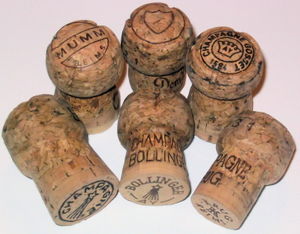Ways of opening a bottle of Champagne
 Broadly speaking, there are two methods of opening a Champagne bottle: the messy way and the proper way. The messy way is to shake the bottle to build up the bubbles within the neck space of the bottle and make a splash when the cork is removed. The other way is to do it like a craftsman and uncork the Champagne in style with safety in mind. The pressure that shot the cork out of the bottle is almost 3X your tyre pressure. It can blind one’s eye if the cork is shot directly into the eye.
Broadly speaking, there are two methods of opening a Champagne bottle: the messy way and the proper way. The messy way is to shake the bottle to build up the bubbles within the neck space of the bottle and make a splash when the cork is removed. The other way is to do it like a craftsman and uncork the Champagne in style with safety in mind. The pressure that shot the cork out of the bottle is almost 3X your tyre pressure. It can blind one’s eye if the cork is shot directly into the eye.So, let me describe the most common methods of safely opening a Champagne bottle. Of course, before opening the Champagne, it must be chilled and is at its serving temperature (10C-12C).
Without splashing
This traditional and least exciting method is to ensure that the cork is being removed in the most controlled condition.
1) Remove the paper seal from the bottle opening and the neck. You can peel it off rather easily using the extended edge of the seal designed for this purpose.
2) After removing the paper seal, it is time to remove the wire cage. From this point onward, your left palm should be over the cork as a precaution and the bottle should be pointed to a safe direction even though the cork is not loosened yet.
3) After removing the wire cage, hold the bottle bottom with your right hand and cover the cork and bottle opening with your left palm (if you are right-handed). Make sure that both your hands are firmly held onto the bottle. Now, you can use your right hand to gently rotate the bottle clockwise to loosen the cork.
The cork should be released from the bottle with a whoof sound and will not fly off to hit any objects. All this while, your left palm is firmly covering the bottle opening and the cork will now sit safely in your left palm.
With a sabre - Sabre à Champagne
This method is ceremonial and fun. You should only do this when there is an open space, preferably in a garden party or a ballroom with high ceiling. The equipment you need is a sword and a bottle of chilled Champagne. If the Champagne is not chilled (above 13C), le sabrage can be dangerous. This art of opening builds on the fact that carbon dioxide gas is most stable at temperature between -56C and 20C. If the Champagne bottle has been left in room temperature (in Singapore context, it will be 28C -35C), some carbon dioxide may be in liquid form and sabrage will leave behind undesired glass debris. Therefore, chill the Champagne to 10C before preparing for sabrage.
Once the Champagne is taken out from its cool storage, use a piece of clean cloth to wipe away the condensation so that you will have a firm grip of the bottle. Next, remove the paper seal and wire cage at the cork as described above. Now, locate the crease along the side of the bottle. This is where two halves of the bottle meets. Notice that the crease goes all the way to the lips of the bottle opening. This part of the lips is the weakest and we will be striking at this point later.
Next, hold the bottle firmly with your left hand (if you are right handed) and hold the sword with your right hand. Point the bottle to a safe position (@45C elevation from ground) and position the sword with the blunt side of the blade against the crease of the lips. Practice a few strokes with the sword gliding down the seam towards the lips of the bottle with applying force. Once you feel confident, slide down the sword along the crease towards the lips with a firm strike. As long as the bottle is chilled and you are applying the appropriate amount of force upon strike, the neck of the bottle will break easily with a gush of Champagne flowing out from the bottle, clearing away any glass debris.
You will pour the first glass into a clear Champagne flute and check to make sure that there is no floating glass pieces. Once this is confirmed, normal serving can proceed.
By Cher Lim
Wine Treasures Pte Ltd
http://www.wine-treasures.com/
Email: cher.lim@wine-treasures.com
Labels: All about Champagne, Learn about wine

